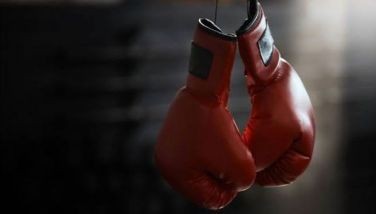Miguel López de Legazpi: the friendly conquistador
February 29, 2004 | 12:00am
 In Mid-May of 1571, A Spanish Fleet of three ships and numerous Visayan allies anchored off Kawit, Cavite. Rajah Soliman did not intend to repeat his defeat at the hands of Martin de Goiti the previous year; his heart craved revenge. But to Maynilad inhabitants’ bafflement, the invaders halted at mid-bay; no shot was fired.
In Mid-May of 1571, A Spanish Fleet of three ships and numerous Visayan allies anchored off Kawit, Cavite. Rajah Soliman did not intend to repeat his defeat at the hands of Martin de Goiti the previous year; his heart craved revenge. But to Maynilad inhabitants’ bafflement, the invaders halted at mid-bay; no shot was fired.
Was this some kind of a tactic? Should the Muslim king sound the war cry before they are caught off guard?
Rajah Soliman heeded his uncle´s advice: Rajah Matanda conferred with Lakan Dula of Tondo, and both met the foreigners to sue for peace.
The commander of the Spanish fleet, Don Miguel López de Legazpi, "turned out to be a white-bearded grandfather, rather stern of eye, but very cordial and courteous", as Nick Joaquin relates in Manila, My Manila. Contrary to the natives’ expectations, the foreigners explained that they harbored no grudge against the reigning Soliman for taking up arms against them and instead offered friendship.
On May 19, 1571, after a peaceful dialogue with the three most influential rajahs of the region–Matanda, Lakan Dula and Soliman–Miguel López de Legazpi occupied Manila in the name of the kingdom of Spain. On June 3, 1571, he formally gave it the title of city, proclaiming it as the country’s capital and permanent seat of the Spanish Kingdom in the East.
The colonization of the Philippines had begun another chapter in the life of this rather pacific Spanish envoy, and a turning point in the history of our country. It was during Legazpi’s governorship that Manila’s economic potentials were unveiled to the world in what has come to be known as the Galleon Trade.
If there was a moment in world history when Manila appeared with distinction, it would have been during this period. It was not only the Ever Loyal and Distinguished City for Spain (a title awarded to cities that had distinguished themselves with a martial victory or some signal service to the Crown), but also the core of commercial activities of Asian countries like Japan, Siam and China who would come to offer products for the Manila Galleon Trade. Likewise for the West–Spain, Mexico, Colombia, Peru and Guatemala–these galleon ships were sources of rich spices and other sought-after goods. After a while, the trade was confined to the Manila-Acapulco route as businessmen of the other Latin American countries declared that such importation posed a harmful threat to the local economy.
The Manila Galleon was regarded as "the first world economy of the modern times". While Manila introduced the East to the West as a haven of spices, artifacts, silks and linens, jewels and ceramics, Mexico and Spain provided Manila rich occidental culture and economic affluence. So important had it become for the entire Empire that it was given the privilege of a Real Audiencia or Supreme Court. At that time, only three cities were granted such a privilege; the other two were Mexico and Lima. Under the leadership of Legazpi, Manila changed from an enclaved isolated island to an affluent open port of the world.
In Spain, Legazpi is known as the founder of Manila. In the Philippines, he is the friendly coquistador. To the world, he is an epitome of loyalty, courage and self-giving.
Legazpi was born 500 years ago in the small Basque town of Zumarraga. The second son of a government scrivener of noble descent, he migrated to Mexico in 1528 and, a year after, married Isabel Garcés. They had nine children.
He started as a government official, later rose to occupy significant positions until he became the mayor of the city of Mexico (then, the virreinato of Nueva España). His life in Mexico was so peaceful and normal that it permitted him to concentrate on his family and its good keep.
This normality was disturbed only when he was commissioned for an expedition to the Philippines. He was then already in his late 60s and widowed. With this new task, he did not only have to leave the colonial capital where he served for more than 30 years, but also had to sacrifice his personal properties. Records show that the wedding of Elvira de Legazpi had to be cancelled as her father had sold practically all his fortune to finance the expedition. He did everything for the glory of the Crown and later, for the Filipino people. He so detached himself of lust and material wealth that when he died (in Manila), he hardly had enough pesos left to pay for his own burial.
Miguel López de Legazpi was a conquistador without a sword, a warrior who won the islands of the Philippines through loyalty and kind words rather than deception and military vehemence. He was not a great navigator like Urdaneta but a military man whose primary recourse was prayer and dialogue rather than arms.
Legazpi was the adelantado who knew how to carry out what the Spanish Crown wished for the colonized islands of the Pacific, a mission that was not easy.
If he experienced success where others failed, it was because his entire expedition was one of brotherhood rather than of conquest. Instead of drawing his sword, he cut his wrist to seal a pact with Rajah Sikatuna in the Blood Compact of Bohol, a local gesture of fraternity and equality.
As Governor-General of Manila, Legazpi was said to have engaged in conversation with the Muslims–then the principal inhabitants of the city–to learn more about their world. He knew how to combine the great culture and monotheism of the locals with allegiance to the throne. Though one of his principal objectives was to evangelize the islands, never did he impose religion with force.
From the very start, religiosity marked Legazpi´s expedition. His major vessels were named after the saints. He gave the first island he landed on the name San Miguel and celebrated the founding of the Spanish city of Manila with a solemn Mass. He conquered with a loud cry for the glory of God. His preachings were of example rather than force and mere words.
As Mayor Lito Atienza of Manila affirms: "The arrival of Miguel López de Legazpi to Manila marked the beginning of a fundamental stage in the formation of our country as it was him who introduced us to western values such as Christianity, now an integral part of our national identity".
A little after noon of August 20, 1572, Legazpi finished lunch. A man of a kind heart, he continued to be bothered by the argument he just had with one of his men about disobedience and some abuses. A few minutes later, he began to feel bad. For some days now, he had this lingering pain that paralyzed half of his body and he could not talk with ease. At nightfall, a cardiac arrest ended his life. His paralysis impeded him from receiving the last sacraments, but the confession he had five days ago with an Augustinian friar prepared him for death.
He was 70 years old. He only served a year as Governor-General of Manila, a city he lavished with privileges and decorations. Loved and respected by his colleagues and subordinates alike, everyone mourned deeply at his funeral. His name resounds in history as the prudent and peaceful conquistador.
Commemorating Legazpi´s 5th birth centenary is the exhibit "The Philippines: Gateway to the Orient. From Legazpi to Malaspina" at the National Museum from March 4 to April 11. It is organized by seacex (the Spanish official agency on foreign culture) with the collaboration of Instituto Cervantes de Manila. About 200 pieces of artifacts from Spain, Mexico, Portugal, Italy and the Philippines dating as far as the 16th century will be exhibited, including the course and annals of Legazpi´s expedition to Manila in 1564-1565.
BrandSpace Articles
<
>
- Latest
- Trending
Trending
Latest
Trending
Latest
Recommended

















